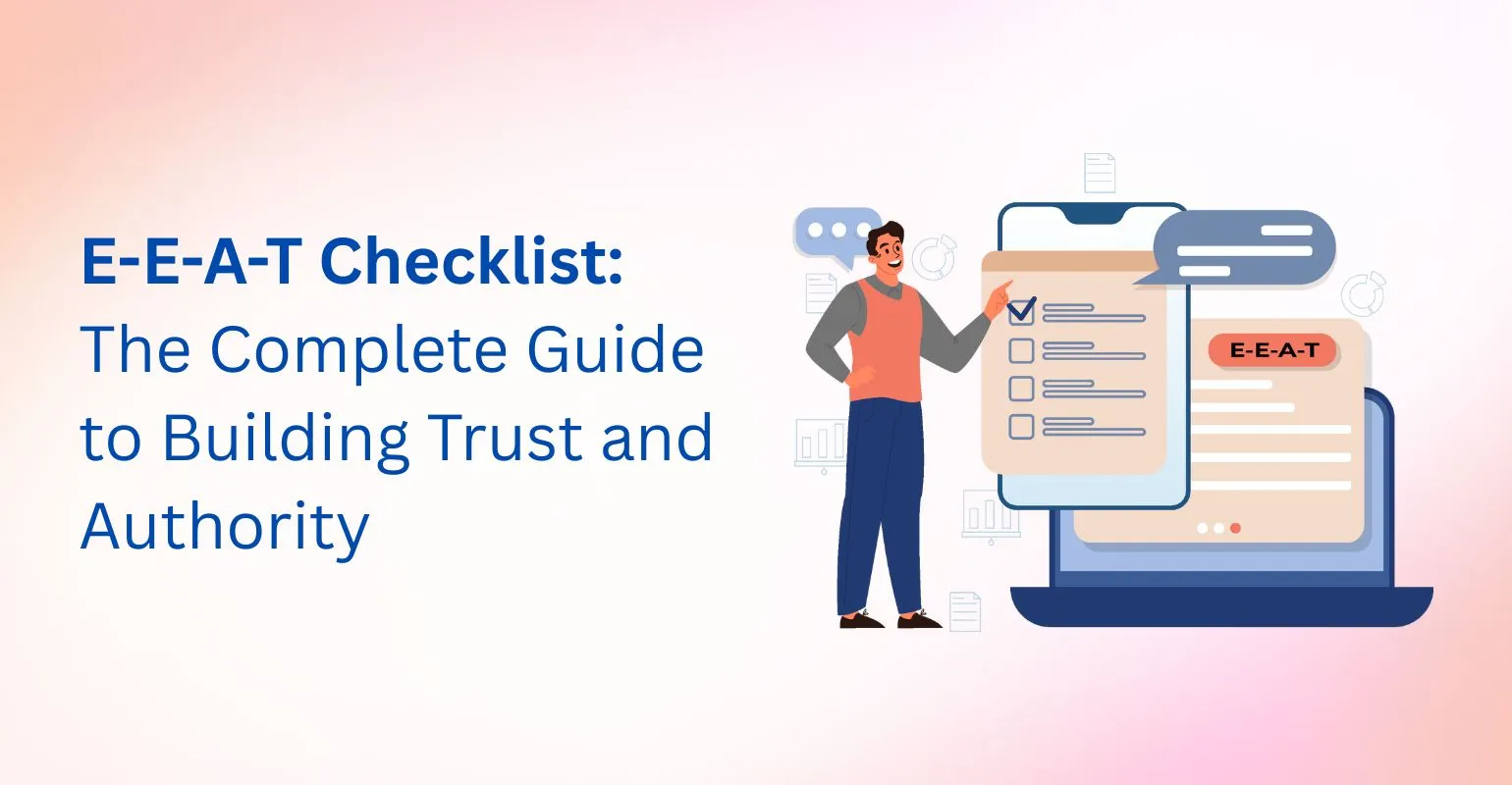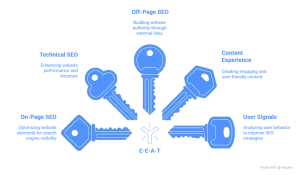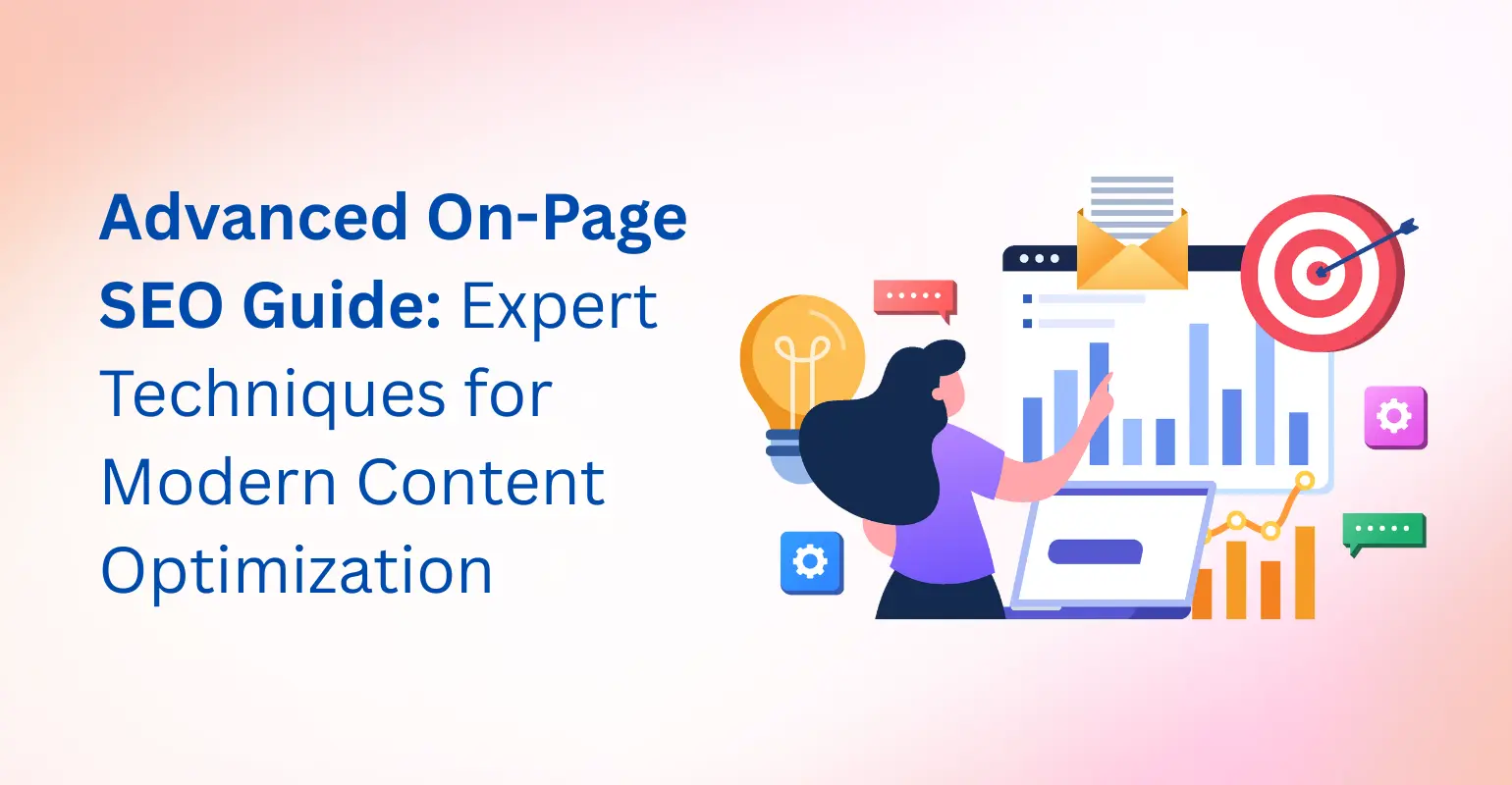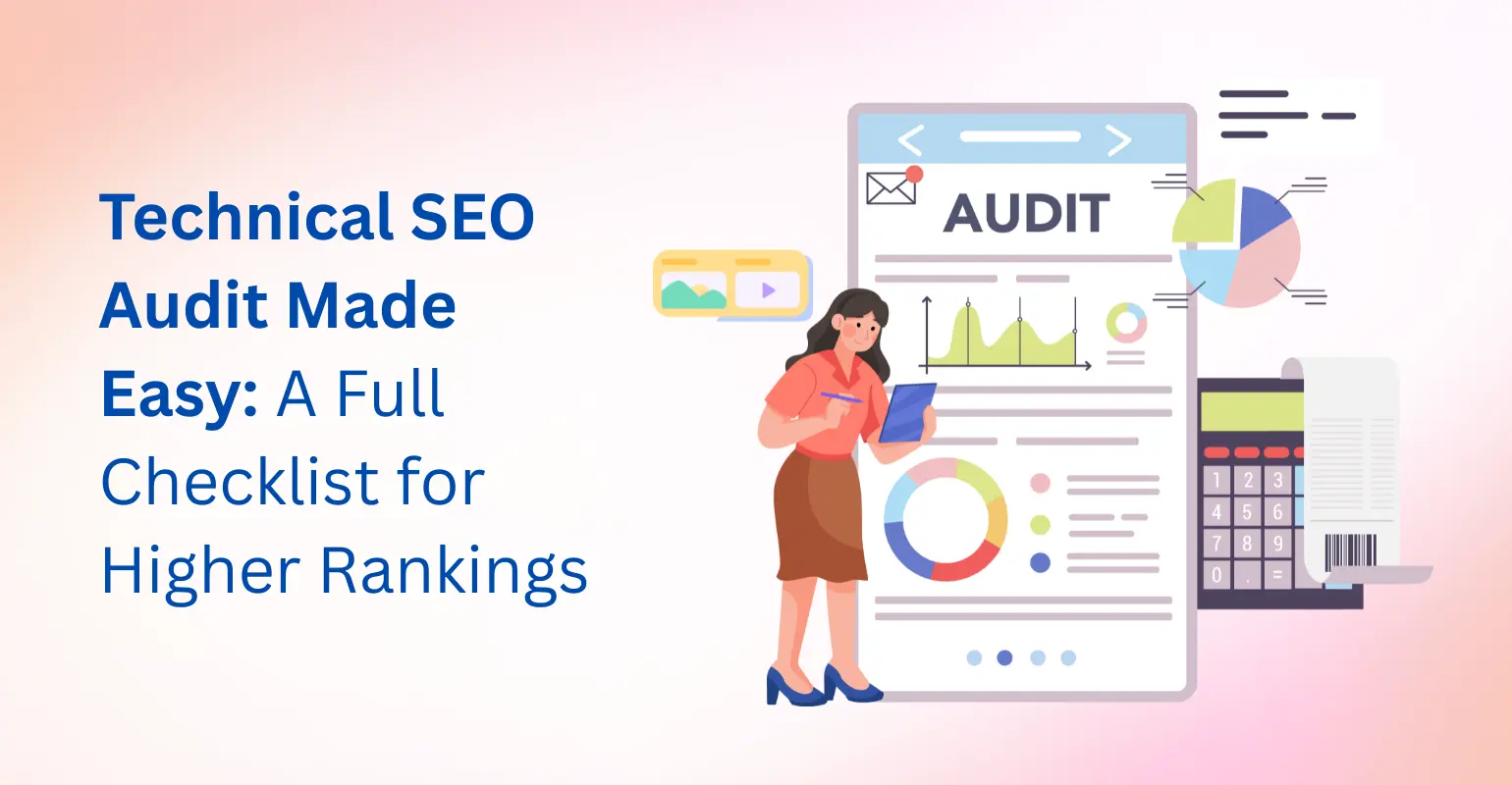blog
E-E-A-T Checklist: The Complete Guide to Building Trust and Authority

In today’s competitive digital landscape, Google rewards websites that demonstrate real-world credibility, expertise, and authenticity. This is where the E-E-A-T Checklist which stands for Experience, Expertise, Authoritativeness, and Trustworthiness comes into play.
As Google’s algorithms become more sophisticated in understanding user intent and content quality, E-E-A-T signals have become crucial ranking factors that separate trustworthy brands from the rest.
Whether you are a business owner, blogger, or SEO strategist, implementing this E-E-A-T checklist is essential to building long-term visibility and authority.
In this complete guide, we will break down every aspect of E-E-A-T, explain why it matters, and show you how to optimize your content for trust, authenticity, and higher rankings.
What is E-E-A-T and Why It Matters
E-E-A-T stands for Experience, Expertise, Authoritativeness, and Trustworthiness, and it comes directly from Google’s Search Quality Evaluator Guidelines.
Here’s what each element means:
- Experience: Your content should reflect first-hand, practical knowledge. Google prefers writers who’ve actually done or used what they’re writing about.
- Expertise: Demonstrate subject mastery. This could be through professional credentials, years of practice, or deep insights that reflect real understanding.
- Authoritativeness: Your brand or author should be recognized by others in the field through mentions, citations, or backlinks from reputable sources.
- Trustworthiness: Above all, your site should be safe, transparent, and accurate. This includes HTTPS security, clear author info, and verified facts.
Initially, Google focused on E-A-T, but in 2022, it added the “Experience” component to emphasize the value of authentic, human-first content.
In short, E-E-A-T represents the foundation of modern SEO content quality.
Here’s a quick breakdown of the E-E-A-T framework you can reference throughout this checklist:
| E-E-A-T Element | Meaning | Why It Matters for SEO | Example of Implementation |
|---|---|---|---|
| Experience (E) | Content reflects real, first-hand experience or insights. | Builds authenticity and relatability—Google favors genuine perspectives. | Case studies, personal stories, or original research. |
| Expertise (E) | Content is created by a qualified or knowledgeable author. | Enhances topical authority and factual accuracy. | Author credentials, verified certifications, expert quotes. |
| Authoritativeness (A) | Recognition from other trusted sources in your niche. | Improves backlink quality, mentions, and content credibility. | Guest features, citations from reputed publications. |
| Trustworthiness (T) | The transparency, accuracy, and reliability of your website. | Boosts user confidence and ranking stability. | HTTPS, visible contact info, privacy policy, honest reviews. |
Why Following an E-E-A-T Checklist Is Essential for SEO Success
Google’s mission is simple: provide users with the most reliable and helpful results possible. To do that, it uses E-E-A-T principles to assess whether your content deserves to rank high.
Let’s take an example. Imagine two articles on “How to Manage Diabetes.”
- One is written by a medical professional citing clinical sources.
- The other is a random blog post with no credentials or references.
Even if both are optimized for keywords, Google will favor the one that shows stronger E-E-A-T signals; because it can be trusted by readers.
In YMYL (Your Money or Your Life) categories; like healthcare, finance, or legal content; E-E-A-T can make or break your rankings. But even outside these sectors, it’s become the backbone of modern SEO.
By following this E-E-A-T Checklist, you can:
- Boost your site’s credibility and brand image.
- Attract organic backlinks from authoritative domains.
- Reduce bounce rates by creating engaging, trustworthy content.
- Future-proof your SEO strategy against algorithm updates.
The Ultimate E-E-A-T Checklist: 12 Key Elements You Must Implement
Here’s a step-by-step E-E-A-T checklist to help you strengthen every signal Google looks for.

Image Source: Created using Napkin AI.
1. Demonstrate First-hand Experience
Google values experience because it reflects authenticity. Add:
- Case studies, client examples, or personal results.
- Original images, screenshots, and data.
- Real-world insights; something AI or generic writers can’t replicate.
Example: Instead of writing “SEO improves traffic,” say “At XYZ, we increased organic traffic by 47% in 3 months using an E-E-A-T-focused strategy.”
2. Showcase Author Credentials
Your authors should have visible expertise.
- Add author bios with educational background, certifications, or relevant experience.
- Link to social profiles like LinkedIn or expert directories.
- For blogs, include an “About the Author” box with a short professional summary.
This boosts transparency and builds reader confidence.
3. Optimize Your “About Us” Page
Your website should clearly state who you are and why you can be trusted.
Include:
- Company history and mission statement.
- Team profiles, awards, and certifications.
- Media coverage or client testimonials.
A strong About page signals organizational trustworthiness; a core part of this E-E-A-T checklist.
4. Cite Reputable Sources
Google’s quality raters expect accuracy.
- Back your claims with links to reliable sources like government websites, academic papers, or respected publications.
- Avoid linking to competitors or low-quality domains.
- Use outbound links strategically to reinforce authority.
When you support your claims with data, you strengthen both trust and SEO relevance.
5. Keep Content Updated
Outdated information hurts credibility.
- Regularly review older posts for broken links or obsolete stats.
- Add “Last updated on” dates for transparency.
- Refresh high-performing blogs with new insights annually.
Keeping your content fresh tells Google and readers that your website is alive, active, and dependable.
6. Build High-Quality Backlinks
Authority is built on reputation.
- Earn backlinks from news portals, industry blogs, and niche directories.
- Publish guest articles with genuine insights, not keyword stuffing.
- Avoid buying links or participating in PBNs.
Backlinks act as “votes of confidence,” reinforcing your site’s authoritativeness and trustworthiness.
7. Encourage User Reviews and Testimonials
Social proof is a major trust signal.
- Request reviews on your Google Business Profile and social platforms.
- Display real testimonials with verified names or photos.
- Respond to both positive and negative reviews professionally.
Genuine feedback adds authenticity to your brand story.
8. Secure Your Website (HTTPS + Privacy Policy)
A secure site isn’t optional anymore.
- Install SSL certificates (HTTPS).
- Include a visible Privacy Policy, Terms of Service, and Cookie Policy.
- Ensure your contact information is easy to find.
Google flags insecure or deceptive sites; so prioritize security in your E-E-A-T checklist.
9. Maintain Consistent Brand Identity
Consistency builds recognition and trust.
- Use the same tone, colors, and logo across channels.
- Align your messaging on blogs, social media, and ads.
- Avoid contradictory information or mixed branding.
A unified voice conveys professionalism and reliability.
10. Highlight External Mentions and Partnerships
Show that others in your industry respect your authority.
- Feature press mentions, certifications, or collaborations.
- Add a “Featured In” section with logos of recognized publications.
- Showcase guest appearances or quotes from thought leaders.
Third-party validation enhances authoritativeness in Google’s eyes.
11. Create In-Depth, Comprehensive Content
Thin or superficial posts don’t rank anymore.
- Write long-form, value-driven content that addresses user intent.
- Include multimedia (infographics, videos, charts).
- Use internal linking to connect related pages.
- Implement structured data (schema) for FAQs and reviews.
When readers stay longer, engage more, and share your content, Google perceives higher trust and expertise.
12. Regularly Audit Your E-E-A-T Performance
E-E-A-T optimization is continuous.
- Review content accuracy, author bios, and citations monthly.
- Use SEO tools like Ahrefs, SurferSEO, and Google Search Console.
- Track backlinks, mentions, and engagement metrics.
Make E-E-A-T audits part of your SEO maintenance routine.
Common E-E-A-T Mistakes That Can Hurt Your Rankings
Even with the best intentions, many websites unknowingly weaken their E-E-A-T signals, making it harder to rank on Google. Here are the most common mistakes to avoid and how to fix them:
1. Publishing Anonymous Content:
Google’s evaluators value transparency. When articles lack author bios or credentials, it signals low trust. Always include the author’s name, qualifications, and links to credible profiles (like LinkedIn or expert directories).
2. Using AI-Generated Content Without Human Oversight:
While AI can speed up writing, relying solely on it can lead to factual errors or generic tone. Always edit, verify, and add personal insights before publishing. Human editing reinforces authenticity and aligns with the E-E-A-T Checklist.
3. Failing to Cite or Verify Facts:
Unsupported claims or missing citations lower your authority. Link to reputable sources like government sites, journals, or recognized experts. Verified data builds both user and Google confidence.
4. Buying Fake Reviews or Backlinks:
Artificial reputation signals can backfire. Google’s algorithms can detect spammy backlinks and fake testimonials. Focus on genuine outreach and organic relationship building instead.
5. Ignoring Website Security or Broken Links:
HTTPS, privacy policies, and functioning links are trust fundamentals. Regularly audit your site’s technical health to maintain user safety and credibility.
Fixing these errors strengthens your brand’s expertise, authority, and trustworthiness; core pillars of the E-E-A-T framework.
| Mistake | Impact on Rankings | Fix Using the E-E-A-T Checklist |
|---|---|---|
| Publishing anonymous or AI-only content | Reduces credibility and author transparency. | Add verified author bios and human review layers. |
| Failing to fact-check or cite sources | Lowers trust and topical authority. | Include references, citations, and date stamps. |
| Ignoring website security or broken links | Signals unreliability and poor maintenance. | Enable SSL, fix broken links, and update outdated pages. |
| Buying fake backlinks or reviews | Triggers spam filters and algorithm penalties. | Build organic backlinks through PR, guest posts, and genuine mentions. |
| Using outdated data or statistics | Weakens expertise and user trust. | Update facts regularly with credible, current sources. |
How to Audit Your Website Using the E-E-A-T Checklist
A well-structured E-E-A-T audit helps identify weaknesses and build stronger trust signals across your digital presence. Here’s how to systematically evaluate your website:
1. Analyze Author Profiles:
Ensure each piece of content lists a qualified, visible author. Include professional credentials, relevant experience, and links to authoritative social profiles. This adds authenticity and expertise.
2. Check Content Accuracy:
Review your blogs and landing pages for outdated or misleading information. Update stats, refresh insights, and ensure all facts are verifiable. Accurate content reflects reliability.
3. Evaluate Backlinks and Mentions:
Use tools like Ahrefs, Moz, or SEMrush to identify referring domains. Remove or disavow toxic backlinks and focus on acquiring mentions from reputable websites in your industry.
4. Assess User Experience (UX) and Design:
A cluttered interface or poor readability can undermine authority. Optimize for mobile, ensure fast loading times, and maintain consistent formatting across pages.
5. Review Security and Policies:
Make sure your site uses HTTPS, includes privacy policies, and provides clear contact information. These are fundamental trust signals under the E-E-A-T Checklist.
6. Benchmark Competitors:
Study how top-ranking competitors present expertise and authority. Compare author pages, backlinks, and on-page signals to identify improvement opportunities.
Repeat this audit every quarter to ensure your website stays compliant with Google’s evolving E-E-A-T standards.
How E-E-A-T Interacts with Other SEO Factors
E-E-A-T is not a standalone concept it strengthens every part of your SEO ecosystem. Here’s how it interacts with other optimization pillars:
1. On-Page SEO:
Elements like headings, meta descriptions, and keyword placement enhance visibility, but E-E-A-T ensures the content behind them is trustworthy. A strong E-E-A-T Checklist complements your keyword strategy by proving content authenticity.
2. Technical SEO:
Site performance, Core Web Vitals, and mobile optimization directly impact user trust. A technically sound website signals reliability, which aligns with the “Trustworthiness” pillar of E-E-A-T.
3. Off-Page SEO:
Backlinks and brand mentions are key authority signals. When respected websites reference your brand, Google sees this as validation of expertise and authoritativeness.
4. Content Experience (CX):
Great design, accessibility, and readability foster engagement. When users stay longer and interact with your content, it enhances perceived credibility.
5. User Signals and Behavior:
High click-through rates, low bounce rates, and repeat visits demonstrate satisfaction and trust indirectly reinforcing E-E-A-T performance.
Think of E-E-A-T as the trust layer that integrates with technical, on-page, and off-page SEO, transforming optimization efforts into sustainable ranking power.

Image Source: Created using Napkin AI.
Future of E-E-A-T: What to Expect Beyond 2025
The future of SEO lies in authentic, verifiable, and experience-driven content. As Google advances its AI detection and content quality evaluation, here’s how E-E-A-T will evolve:
1. Emphasis on Verified Author Identities:
Expect Google to prioritize verified and transparent author profiles. Articles without clear credentials or real authorship may struggle to rank. Establishing digital authority will be vital.
2. Greater Focus on Transparent Sourcing:
Fact-checking and data transparency will become more important. Linking to credible sources, using citations, and referencing original data will directly impact rankings.
3. Rise of First-Hand Case Studies and Real-World Insights:
Experience-driven content like success stories, customer results, or field examples will outperform generic advice. Google wants proof of lived experience.
4. Increased Value of Reputation Signals:
User reviews, brand mentions, and third-party endorsements will serve as external validators of authority. Online reputation management will become part of every E-E-A-T optimization strategy.
5. Enhanced Integration with AI-Driven Search:
As AI tools (like Search Generative Experience) evolve, E-E-A-T will guide which sources are cited or featured. Only brands that demonstrate trust and expertise will appear in AI summaries.
Brands that adopt the E-E-A-T Checklist today by building genuine authority and transparency will lead the next era of SEO built on credibility and human value.
Final Thoughts
Following the E-E-A-T Checklist isn’t just about rankings, it’s about building digital trust that lasts. By combining experience, expertise, authority, and transparency, you create content that Google and your audience can believe in.
If you want expert help implementing these E-E-A-T optimization techniques, Tangence can help.
As a leading SEO agency, Tangence specializes in: Full-scale E-E-A-T audits, Authority-driven link building, On-page trust optimization, Transparent monthly reporting
Our team ensures your content meets Google’s latest quality guidelines while positioning your brand as a trusted leader in its niche.
Boost your website’s credibility and rankings partner with Tangence’s SEO experts today!
Frequently Aske Questions
1. What does E-E-A-T stand for in SEO?
E-E-A-T stands for Experience, Expertise, Authoritativeness, and Trustworthiness. It’s Google’s framework for evaluating whether a website provides accurate, credible, and useful content.
2. How can I use the E-E-A-T Checklist to improve my rankings?
Use the checklist to enhance your credibility: add author bios, cite reliable sources, secure your site, and regularly update content. These steps signal trust to both users and Google.
3. Is E-E-A-T a direct ranking factor?
Not exactly but it strongly influences how Google ranks your content. It shapes how algorithms assess page quality, authority, and expertise.
4. How do I demonstrate experience on my website?
Share first-hand knowledge through case studies, testimonials, original images, and personal stories. Google favors authentic, human-created experiences.
5. Can AI-generated content satisfy E-E-A-T requirements?
Yes, if it’s fact-checked, edited, and published under an expert’s supervision. Human oversight remains essential for credibility.
6. What tools can I use to analyze E-E-A-T performance?
Tools like Ahrefs, Google Search Console, and SurferSEO help monitor backlinks, content authority, and technical trust signals.
7. How can Tangence help with E-E-A-T optimization?
Tangence offers comprehensive SEO services including E-E-A-T audits, backlink outreach, and content optimization to help your brand build trust, boost visibility, and dominate Google rankings.




